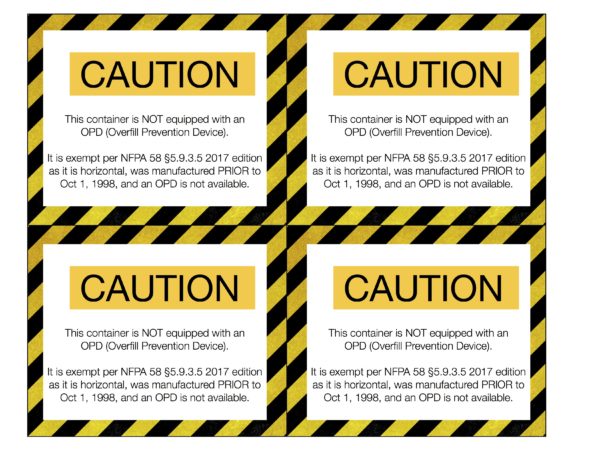When we purchased Emet, she had 2 aluminum horizontal 10 lb propane tanks on board. They both had one more year left on their qualification. I figured getting them requalified would be no problem as they were both in good condition with no corrosion or pitting and the valves were in good shape as well.
Just a few minutes from Blue Dolphin there was a propane place. Carlos was the guy that worked there. I went by one day and after if he requalified tanks. He said that he didn’t do it there, but that he sent them off to have them done. Perfect.
So, when the time came, I dropped one tank off to him and told him to get it requalified and to fill it for me when it got back. Within a week, he called and said the tank was ready to go. He told me, “These old tanks are great. Make sure you tank care of this one and don’t ever get rid of it.” Will do. Especially as it would be close to $700 to replace both of them. When the second one was due, I dropped it off to him and got it requalified and filled.
We used Carlos exclusively for filling our tanks and never had a problem.
When we moved down to Harborwalk, we had to find a propane filler that was a little closer. We drove down Hwy 6 until we found a place.
Now, each 10 lb tank will last us 1 month under normal usage. We make coffee every morning and sometimes cook breakfast and almost always cook dinner. When one tank is empty, I swap the supply line over to the full one and then take the empty to get it filled. I really don’t like going more than a week with an empty tank. You just never know if something weird is going to happen like not quite getting the connection tight and all your propane leaking out and you are stuck with a pot of stew that is not quite done or a loaf of bread only half baked in the oven. OR EVEN WORSE . . . a pizza in the oven and the flame goes out before it’s done. Oh the horror!! We haven’t had this happen. Yet. But, I’m really paranoid about running out of propane and not being able to get the tanks filled in a reasonable time.
So, when one our first tank went empty, I made the trek over to the new propane store. I expected everything to go swimmingly. It did . . . sort of.
“I haven’t seen a tank like this in forever. Where’d you get this?”
“It was on a sailboat when we bought it”
The propane guy is turning the tank over and around, “Who requalified this tank for you?”
“A guy over in Seabrook sent it off to get it done.”
“I can’t believe they requalified this thing. But, I didn’t do it and it’s got a sticker, so I’ll fill it up for you.”
Well. Hhhmm. Thanks?!? I think.
Now, I’ve been back to this guy no less than 6 times. AND . . . EVERY . . . SINGLE . . . TIME . . . we have the same discussion: “Who requalified? I can’t believe they did it. i wouldn’t do it. But, since they did it, I’ll fill it. You got this off a boat?”
This last time I told him that as far as I remember, the tanks are exempt from the OPD requirement because they don’t offer an OPD for the older horizontal tanks.
“That’s because they can’t be retrofitted. And they aren’t supposed to be requalified anymore. I don’t know the regulations on it though,” he tells me as he proceeds to refill the tank.
I’m just mildly irritated at this. I mean, this guy has seen me each month for the last 6 months. And why doesn’t he know the rules for the job that he’s performing?
I get back and express my frustration to Jodi. She just kind of chuckles.
I resolve to find out what the heck is going on with my tanks because I’ll be hog tied if I’m gonna shell out $700 because some gov’t agency has decided that I need “new ones to make me safer.” Remember that plastic, ventless, gas tank fiasco in my dinghy?
There was a wealth of misleading and not quite correct information on the web. Who would have thunk it?
Here’s the scoop:
The NFPA came out with the 1998 edition of NFPA 58. This standard covers pretty much anything associated with Liquified Petroleum Gas. It’s not a national or state law, unless a state enacts a law making the text of the standard law. The Federal DOT regulates portable propane containers, but here’s what NFPA 58 1998, which numerous states enacted as law, said about propane containers:
2-3.1.5 Cylinders with 4 lb (1.8 kg) through 40 lb (18 kg) propane capacity for vapor service shall comply with the following:
(a) * Cylinders fabricated after September 30, 1998, shall be equipped or fitted with a listed overfilling prevention device and a fixed maximum liquid level gauge. These devices shall be part of the container assembly. The length of the fixed maximum liquid level gauge dip tube shall be in accordance with 4-4.3.3(a).
(b) Cylinders requalified after September 30, 1998, shall be equipped with an overfilling prevention device and a fixed maximum liquid level gauge prior to being filled.
(c) Effective April 1, 2002, no cylinder shall be filled unless it is equipped with an overfilling prevention device and a fixed maximum liquid level gauge. The length of the fixed maximum liquid level gauge dip tube shall be in accordance with 4-4.3.3(a).
(d) Cylinders required to have an overfilling prevention device installed shall be equipped with either a CGA connection number 791 or a CGA connection number 810 as described in CGA Publication V-1.
Exception: All cylinders used in industrial truck service (including forklift truck cylinders) and cylinders identified and used for industrial welding and cutting gases shall be exempt from these requirements.
So, as of 1998, our tanks that were made in 1981 and 1988 can no longer be used.
But, wait . . . there’s more.
In 2001, the NFPA revised the code to allow one more exception and the applicable section was 5.7.3.5.
This is from the 2004 edition:
5.7.6 Overfilling Prevention Devices. 5.7.6.1 Cylinders with 4 lb (1.8 kg) through 40 lb (18 kg) propane capacity for vapor service shall be equipped or fitted with a listed overfilling prevention device and a fixed maxi- mum liquid level gauge. These devices shall be permitted to be a part of the container valve assembly. 5.7.6.2* Cylinders requalified after September 30, 1998, shall be equipped with a listed overfilling prevention device and a fixed maximum liquid level gauge, sized in accordance with 7.4.3.2(A) or Table 5.7.6.2, prior to being filled. Table 5.7.6.2 Recommended Dip Tube Lengths for Various Cylinders (TABLE OMITTED)Note: This table indicates the approximate fixed maximum liquid level gauge dip tube lengths to be used for retrofitting cylinders with valves incorporating an overfilling prevention device. This table does not cover every cylinder design or configuration. 5.7.6.3 No cylinder shall be filled unless it is equipped with an overfilling prevention device and a fixed maximum liquid level gauge. The length of the fixed maximum liquid level gauge dip tube shall be in accordance with 7.4.3.2(A) or Table 5.7.6.2. 5.7.6.4 Cylinders required to have an overfilling prevention de- vice installed shall be equipped with either a CGA connection number 791 or a CGA connection number 810 as described in CGA VI , Standard Compressed Gas Cylinder Valve Outlet and Inlet Connections. 5.7.6.5 The following types of cylinders shall be exempt from the requirements of 5.7.6.1 through 5.7.6.4 for installing a listed overfilling prevention device: (1) Cylinders used in industrial truck service and cylinders identified and used for industrial welding and cutting gases (2) Cylinders manufactured prior to October 1, 1998, and designed for use in the horizontal position and where an overfilling prevention device is not available 5.7.6.6 Exempted horizontal cylinders shall be marked with a label to indicate that they are not equipped with an overfilling prevention device.
Now, the NFPA is up to a 2017 version of this standard and all of this text has been moved to section 5.9.3. 5.9.3.5 is now what 5.7.6.5 above was and 5.9.3.6 replaces 5.7.6.6.
In the end our tanks are legal. However, whoever requalified our tanks did NOT mark them per 5.7.6.6 above. So, I made some labels and will get them applied before I take a tank back to be filled.

